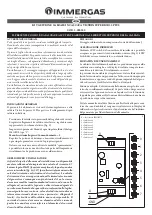
SERVICE AND SPARES
Greenstar Ri Compact 6 720 646 610 (2013/12)
37
6.7
CLEANING THE HEAT EXCHANGER
The following items will have to be removed to gain access to the heat
exchanger for cleaning:
▶ Lower the control panel into the service position.
▶ Remove the case.
▶ Disconnect electrical wires to the fan, ignition transformer, spark
electrodes, flue overheat thermostat, main heat exchanger
temperature sensor and flow pipe temperature sensor.
▶ Flueway
▶ Fan assembly
▶ Ignition transformer
▶ Spark electrode assembly
▶ Burner housing, burner and gasket
Refer to sections 6.8.9 to 6.8.13 for instructions on how to remove the
items to gain access to the heat exchanger channels so that the heat
exchanger can be cleaned
6.7.1 CLEANING THE SIPHON
▶ The Control panel will have to be removed to gain access to the siphon
for removal and cleaning, refer to section 6.8.3
1. Disconnect the discharge hose from the condensate pipe.
2. Rotate the siphon body clockwise to release the bayonet connection.
3. Pull the siphon body down and away from the boiler.
▶ Empty the water and debris into a suitable container.
▶ Visually inspect the siphon to ensure that it is clean and free from
debris.
▶ Fill the siphon with 200 to 250ml of clean water before refitting.
Fig. 70 Cleaning the siphon
REFITTING THE SIPHON
▶ Fill siphon with 200 to 250 millilitres of water.
1. Push the siphon up onto the sump assembly until it fully engages with
the sump connection.
2. Twist the siphon to the left to secure the bayonet connection.
3. Push the discharge hose, onto condensate pipe so that at least 25mm
of the condensate pipe is inserted into the discharge hose.
Fig. 71 Fitting siphon
6.7.2
CLEANING THE PRIMARY HEAT EXCHANGER
SINGLE BLADED TOOL AND BRUSH
Use a suitable blade to clean the heat exchanger channels.
There is an optional tool available to clean the heat exchanger, part
number 7 746 901 479.
Fig. 72 Single-bladed cleaning tool and brush
▶ Visually inspect the inside of the heat exchanger by shining a torch
from the top down into the sump area.
▶ When there is little or no light visible this would suggest that those
channel(s) are restricted.
▶ It is recommended that all channels are cleaned.
▶ Remove the siphon and place a suitable container under the outlet to
catch the water and debris.
▶ Protect the controller from water ingress.
To clean the rear and middle channel of the heat exchanger
1. Orient the cleaning tool (2) as shown in figure 73 and insert the tool
into the rear or middle channels for cleaning.
2. Move the cleaning tool handle in an up and down motion, using the
front edge of the heat exchanger as a pivot, to clean the channel.
NOTICE:
Gaskets and seals
▶ Replace the burner and electrode assembly gaskets
and the Flueway sump seal after cleaning the heat
exchanger.
Do not attempt the cleaning procedure unless new
gaskets and seals are available.
There is an optional tool available to assist in cleaning the
heat exchanger,
part number 7 746 901 479
NOTICE: Do not
use solvents, adhesive or lubricant
when pushing the pipe onto the rubber connector.
6720646610-48.1W
o
3.
2.
1.
CAUTION:
Component replacement:
▶ After replacement of a gas related component, where
a gasket or seal has been disturbed or replaced, check
for gas tightness using a gas sniffer/analyser.
▶ Also after re-assembly, carry out the following
checks:
Fan pressure in section 6.5,
Flue gas analysis in section 6.6,
6720646610-69.1W
o
1.
2.
3.
6720803800-02.1Wo
1
2
















































